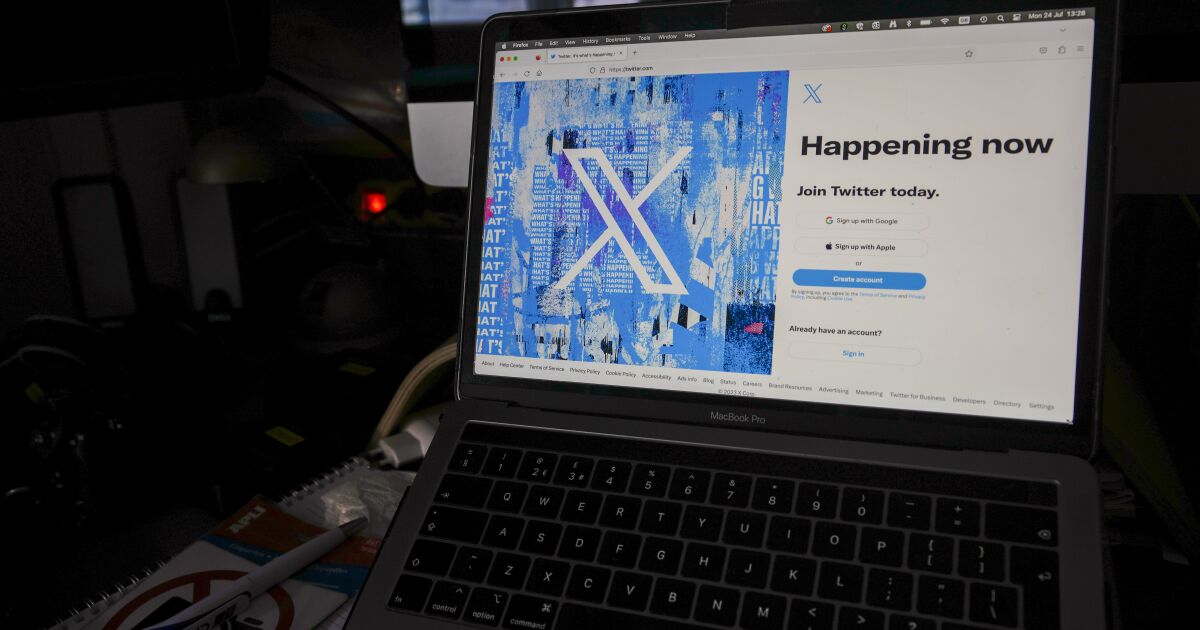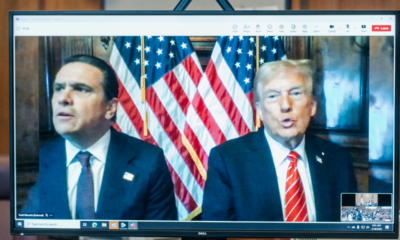Business
Column: It’s the end of social media as we know it. We should feel fine

A nasty summer cold knocked me out recently for a couple of days. I cranked up the fan and the bad TV, as one does, and zoned out. When I came to, and it was time to get my bearings and get back to work, the first order of business was the same as it ever was: log onto social media.
When I did, I instantly sensed that something was off. Seriously off.
So much so that I couldn’t help but finally, grudgingly agree with the critics who’ve been warning that we are witnessing the end of days for the social media network as we knew it.
On Twitter — excuse me, X — there seemed to be as many ads for Cheech and Chong’s cannabis products as posts from people I actually recognized. When I wrote a post, a reply instantly materialized from a bot trying to interest me in a video about how to make money off crypto. It felt like logging directly into a late-night infomercial.
The alternatives weren’t much better — Threads, Meta’s competing product, launched by Mark Zuckerberg to much fanfare just weeks ago, felt vaguely cheery but ultimately vacant. I saw a handful of posts from the same few users and some promotional content from people I must have followed at some point on Instagram, but whose poolside lives looked altogether alien to me now. It was like being in a well-designed but eerily empty mall, a digital Dawn of the Dead with more photogenic zombies.
I quickly logged off, and it turns out I’m not alone — Threads’ user count has plunged by 82% since its launch less than a month ago. After its meteoric (and overhyped) rise to 100 million users in mere days, Threads has been in a steady nosedive. As of Aug. 1, users were spending just 2.9 minutes a day there, according to one count.
For over a decade, logging onto social media — especially Twitter — has been among the first steps of the day for countless professionals, students, and the very online; a way to instantaneously reenter the fray; get up to date on the latest news, trends and memes. Over the years, despite the chaos that tumbled down its feed, it became an orienting force; a way that we parsed and organized information for the coming day, or week.
That force is, for all intents and purposes, extinguished. I’m not alone in thinking so either — a journalism intern at Bloomberg wrote about how their peers don’t take X seriously and seemed surprised at older colleagues who still do. Resolving to delete the app, the intern remarked that the algorithm seems to downrank news and favor reactionary politics — and it’s hard to argue with that.
But old habits die hard. I’ve been logging onto Twitter at the start of every working day since, oh, 2011; it’s easy to let muscle memory take over and keep refreshing the feed regardless of what’s befallen the place. That’s why taking a break and logging back on is such a stark wake-up call — and I used the occasion to embark on a casual investigation of the state of social media, a year into its supposed death.
So, I headed over to the once-buzzy Bluesky, which seemed to face the opposite issue that Threads did. The place seemed noisy and vibrantbut also all but impenetrable to a lay-user showing up occasionally and without much of a community — it’s the place where Twitter power users and online activists have felt most at home, and that’s great, but I kind of stared blankly for a few minutes, and after no new posts loaded for a minute or two, gave up the ghost.
See, if Threads was a rocket with few actual riders that couldn’t sustain its velocity, Bluesky is like a party on an overstuffed hot air balloon whose engineers are frantically building more decks mid-flight. It has apparently recently passed 1 million users, but its invite-only system means that growth is slow.
On the one hand, that sluggish, deliberate pace of growth can be a good thing, giving the site’s staff ample time to build robust policies and user support — assuming they do in fact do those things. (And there’s still plenty of demand for those invites; whenever I mention having one, I immediately get hounded for it.) On the other, many users may lose interest — and Bluesky may lose its window to supplant the competition.
Finally, I turned to Mastodon, the first of the true-blue Twitter competitors to arise after Musk took the reins and broke out the wrecking ball last year. It’s my favorite of the alternatives, by a wide margin, but it’s also… quiet. Nice and quiet, but quiet nonetheless.
The most pervasive knocks on Mastodon are that it’s confusing for users at first and that it’s relatively hard to find the people you want to follow. I think the first complaint is overstated, while the second rings truer.
I mostly wound up following academics and progressive tech folks on Mastodon. To me, it has the vibe of a great cocktail party after an academic conference: fascinating people, stimulating if polite discussions, and a sense — one you know is dumb and juvenile but still can’t shake — that you’re missing a rager somewhere else.
The empty mall, the airship kegger, the erudite cocktail hour — in theory, you can attend them all. In reality, who has the time?
Twitter has already been eulogized to death, but what was great about it was that it could be all of those things at once. (Bear in mind that we’re talking about the end of one kind of social network — the live-wire feed stuffed with news and commentary, versus the family-and-friends approach of Facebook, which lumbers on, nearly 3-billion users strong.)
It may well come to be that the last 10 years of this kind of centralized digital life will be seen as an aberration, and visiting a more diversified suite of communities, platforms and websites will revert to being the norm, as it was in the 1990s and ‘00s. The science fiction writer Cory Doctorow has argued that this is not only likely but necessary. That the accumulated weight of years of bad policy decisions and the platforms’ evolution into overstuffed monopolies leave little alternative but to let them burn, as we would a wildfire that may appear cataclysmic, but is in fact needed to clear out the forest floor.
Ideally, out of the wreckage, we’ll find our online people once again, under better circumstances and conditions — and if we’re smart, we’ll push for more democratic and responsive platforms in the process.
Or we won’t! And we’ll be freed from a pair of long-standing proclivities — posting and doomscrolling — that could feel as burdensome as they were broadening.
So that’s the state of the social media feed in 2023; fractured and fragmented, siloed and confused. No longer the place where cultural trends become clear, where news breaks or narratives form, but something smaller and messier.
And as we prep for the end times, we should keep in mind that what’s unusual isn’t that Twitter has died — this one thrumming central location where celebrities, politicians, journalists, weird posters and activists all congealed — it’s that it ever managed to exist at all.

Business
Cookies, Cocktails and Mushrooms on the Menu as Justices Hear Bank Fraud Case

In a lively Supreme Court argument on Tuesday that included references to cookies, cocktails and toxic mushrooms, the justices tried to find the line between misleading statements and outright lies in the case of a Chicago politician convicted of making false statements to bank regulators.
The case concerned Patrick Daley Thompson, a former Chicago alderman who is the grandson of one former mayor, Richard J. Daley, and the nephew of another, Richard M. Daley. He conceded that he had misled the regulators but said his statements fell short of the outright falsehoods he said were required to make them criminal.
The justices peppered the lawyers with colorful questions that tried to tease out the difference between false and misleading statements.
Chief Justice John G. Roberts Jr. asked whether a motorist pulled over on suspicion of driving while impaired said something false by stating that he had had one cocktail while omitting that he had also drunk four glasses of wine.
Caroline A. Flynn, a lawyer for the federal government, said that a jury could find the statement to be false because “the officer was asking for a complete account of how much the person had had to drink.”
Justice Ketanji Brown Jackson asked about a child who admitted to eating three cookies when she had consumed 10.
Ms. Flynn said context mattered.
“If the mom had said, ‘Did you eat all the cookies,’ or ‘how many cookies did you eat,’ and the child says, ‘I ate three cookies’ when she ate 10, that’s a false statement,” Ms. Flynn said. “But, if the mom says, ‘Did you eat any cookies,’ and the child says three, that’s not an understatement in response to a specific numerical inquiry.”
Justice Sonia Sotomayor asked whether it was false to label toxic mushrooms as “a hundred percent natural.” Ms. Flynn did not give a direct response.
The case before the court, Thompson v. United States, No. 23-1095, started when Mr. Thompson took out three loans from Washington Federal Bank for Savings between 2011 and 2014. He used the first, for $110,000, to finance a law firm. He used the next loan, for $20,000, to pay a tax bill. He used the third, for $89,000, to repay a debt to another bank.
He made a single payment on the loans, for $390 in 2012. The bank, which did not press him for further payments, went under in 2017.
When the Federal Deposit Insurance Corporation and a loan servicer it had hired sought repayment of the loans plus interest, amounting to about $270,000, Mr. Thompson told them he had borrowed $110,000, which was true in a narrow sense but incomplete.
After negotiations, Mr. Thompson in 2018 paid back the principal but not the interest. More than two years later, federal prosecutors charged him with violating a law making it a crime to give “any false statement or report” to influence the F.D.I.C.
He was convicted and ordered to repay the interest, amounting to about $50,000. He served four months in prison.
Chris C. Gair, a lawyer for Mr. Thompson, said his client’s statements were accurate in context, an assertion that met with skepticism. Justice Elena Kagan noted that the jury had found the statements were false and that a ruling in Mr. Thompson’s favor would require a court to rule that no reasonable juror could have come to that conclusion.
Justices Neil M. Gorsuch and Brett M. Kavanaugh said that issue was not before the court, which had agreed to decide the legal question of whether the federal law, as a general matter, covered misleading statements. Lower courts, they said, could decide whether Mr. Thompson had been properly convicted.
Justice Samuel A. Alito Jr. asked for an example of a misleading statement that was not false. Mr. Gair, who was presenting his first Supreme Court argument, responded by talking about himself.
“If I go back and change my website and say ‘40 years of litigation experience’ and then in bold caps say ‘Supreme Court advocate,’” he said, “that would be, after today, a true statement. It would be misleading to anybody who was thinking about whether to hire me.”
Justice Alito said such a statement was, at most, mildly misleading. But Justice Kagan was impressed.
“Well, it is, though, the humblest answer I’ve ever heard from the Supreme Court podium,” she said, to laughter. “So good show on that one.”
Business
SEC probes B. Riley loan to founder, deals with franchise group

B. Riley Financial Inc. received more demands for information from federal regulators about its dealings with now-bankrupt Franchise Group as well as a personal loan for Chairman and co-founder Bryant Riley.
The Los Angeles-based investment firm and Riley each received additional subpoenas in November from the U.S. Securities and Exchange Commission seeking documents and information about Franchise Group, or FRG, the retail company that was once one of its biggest investments before its collapse last year, according to a long-delayed quarterly filing. The agency also wants to know more about Riley’s pledge of B. Riley shares as collateral for a personal loan, the filing shows.
B. Riley previously received SEC subpoenas in July for information about its dealings with ex-FRG chief executive Brian Kahn, part of a long-running probe that has rocked B. Riley and helped push its shares to their lowest in more than a decade. Bryant Riley, who founded the company in 1997 and built it into one of the biggest U.S. investment firms beyond Wall Street, has been forced to sell assets and raise cash to ease creditors’ concerns.
The firm and Riley “are responding to the subpoenas and are fully cooperating with the SEC,” according to the filing. The company said the subpoenas don’t mean the SEC has determined any violations of law have occurred.
Shares in B. Riley jumped more than 25% in New York trading after the company’s overdue quarterly filing gave investors their first formal look at the firm’s performance in more than half a year. The data included a net loss of more than $435 million for the three months ended June 30. The shares through Monday had plunged more than 80% in the past 12 months, trading for less than $4 each.
B. Riley and Kahn — a longstanding client and friend of Riley’s — teamed up in 2023 to take FRG private in a $2.8-billion deal. The transaction soon came under pressure when Kahn was tagged as an unindicted co-conspirator by authorities in the collapse of an unrelated hedge fund called Prophecy Asset Management, which led to a fraud conviction for one of the fund’s executives.
Kahn has said he didn’t do anything wrong, that he wasn’t aware of any fraud at Prophecy and that he was among those who lost money in the collapse. But federal investigations into his role have spilled over into his dealings with B. Riley and its chairman, who have said internal probes found they “had no involvement with, or knowledge of, any alleged misconduct concerning Mr. Kahn or any of his affiliates.”
FRG filed for Chapter 11 bankruptcy in November, a move that led to hundreds of millions of dollars of losses for B. Riley. The collapse made Riley “personally sick,” he said at the time.
One of the biggest financial problems to arise from the FRG deal was a loan that B. Riley made to Kahn for about $200 million, which was secured against FRG shares. With that company’s collapse into bankruptcy in November wiping out equity holders, the value of the remaining collateral for this debt has now dwindled to only about $2 million, the filing shows.
Griffin writes for Bloomberg.
Business
Starbucks Reverses Its Open-Door Policy for Bathroom Use and Lounging

Starbucks will require people visiting its coffee shops to buy something in order to stay or to use its bathrooms, the company announced in a letter sent to store managers on Monday.
The new policy, outlined in a Code of Conduct, will be enacted later this month and applies to the company’s cafes, patios and bathrooms.
“Implementing a Coffeehouse Code of Conduct is something most retailers already have and is a practical step that helps us prioritize our paying customers who want to sit and enjoy our cafes or need to use the restroom during their visit,” Jaci Anderson, a Starbucks spokeswoman, said in an emailed statement.
Ms. Anderson said that by outlining expectations for customers the company “can create a better environment for everyone.”
The Code of Conduct will be displayed in every store and prohibit behaviors including discrimination, harassment, smoking and panhandling.
People who violate the rules will be asked to leave the store, and employees may call law enforcement, the policy says.
Before implementation of the new policy begins on Jan. 27, store managers will be given 40 hours to prepare stores and workers, according to the company. There will also be training sessions for staff.
This training time will be used to prepare for other new practices, too, including asking customers if they want their drink to stay or to go and offering unlimited free refills of hot or iced coffee to customers who order a drink to stay.
The changes are part of an attempt by the company to prioritize customers and make the stores more inviting, Sara Trilling, the president of Starbucks North America, said in a letter to store managers.
“We know from customers that access to comfortable seating and a clean, safe environment is critical to the Starbucks experience they love,” she wrote. “We’ve also heard from you, our partners, that there is a need to reset expectations for how our spaces should be used, and who uses them.”
The changes come as the company responds to declining sales, falling stock prices and grumbling from activist investors. In August, the company appointed a new chief executive, Brian Niccol.
Mr. Niccol outlined changes the company needed to make in a video in October. “We will simplify our overly complex menu, fix our pricing architecture and ensure that every customer feels Starbucks is worth it every single time they visit,” he said.
The new purchase requirement reverses a policy Starbucks instituted in 2018 that said people could use its cafes and bathrooms even if they had not bought something.
The earlier policy was introduced a month after two Black men were arrested in a Philadelphia Starbucks while waiting to meet another man for a business meeting.
Officials said that the men had asked to use the bathroom, but that an employee had refused the request because they had not purchased anything. An employee then called the police, and part of the ensuing encounter was recorded on video and viewed by millions of people online, prompting boycotts and protests.
In 2022, Howard Schultz, the Starbucks chief executive at the time, said that the company was reconsidering the open-bathroom policy.
-

 Health1 week ago
Health1 week agoOzempic ‘microdosing’ is the new weight-loss trend: Should you try it?
-
/cdn.vox-cdn.com/uploads/chorus_asset/file/25822586/STK169_ZUCKERBERG_MAGA_STKS491_CVIRGINIA_A.jpg)
/cdn.vox-cdn.com/uploads/chorus_asset/file/25822586/STK169_ZUCKERBERG_MAGA_STKS491_CVIRGINIA_A.jpg) Technology6 days ago
Technology6 days agoMeta is highlighting a splintering global approach to online speech
-

 Science4 days ago
Science4 days agoMetro will offer free rides in L.A. through Sunday due to fires
-
/cdn.vox-cdn.com/uploads/chorus_asset/file/25821992/videoframe_720397.png)
/cdn.vox-cdn.com/uploads/chorus_asset/file/25821992/videoframe_720397.png) Technology1 week ago
Technology1 week agoLas Vegas police release ChatGPT logs from the suspect in the Cybertruck explosion
-

 Movie Reviews1 week ago
Movie Reviews1 week ago‘How to Make Millions Before Grandma Dies’ Review: Thai Oscar Entry Is a Disarmingly Sentimental Tear-Jerker
-

 Health1 week ago
Health1 week agoMichael J. Fox honored with Presidential Medal of Freedom for Parkinson’s research efforts
-

 Movie Reviews1 week ago
Movie Reviews1 week agoMovie Review: Millennials try to buy-in or opt-out of the “American Meltdown”
-

 News1 week ago
News1 week agoPhotos: Pacific Palisades Wildfire Engulfs Homes in an L.A. Neighborhood


















